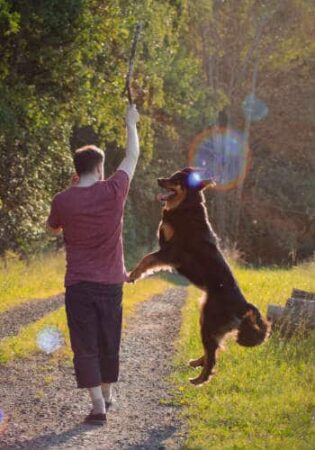Whether you’re worried about strays or worried about your own pet or farm dogs developing a taste for chicken, protecting your flock from predators like dogs is an important part of making sure that your chickens are safe and healthy enough to live long, egg-laying lives.
When dealing with your own dogs, the main priority should be training or discouraging your dogs from attacking your chickens, either through use of physical, social, or chemical deterrents.
When dealing with stray or wild dogs, the best way to keep your chickens safe is to make sure that their coop is a strong, safe place for them to roost.
So let’s discuss this in further detail.
Pet Dogs
For a lot of chicken farmers, chickens aren’t the only animals you’re taking care of. Whether they be pampered family pets or hard-working farm helpers, dogs are natural predators for chickens, and can be a major obstacle to raising your flock. The best way to keep your chickens safe is to work closely with your dogs and train them not to attack the coop.
Barring this, your next best option is to make the coop completely impenetrable, either by physically fortifying the structure or by making use of commercially available chemical products that will discourage your dogs from entering the coop.

Training
Because dogs’ natural instincts are to chase after birds like chickens, training them to ignore or even defend your flock can be a time-consuming task. However, if you are successful, you can rest easy knowing that your chickens are as safe with your dogs as they would be with you. There are several methods you can use to train your dogs, but the most common include:
1. “Drop” Method
This method involves teaching your dog to adopt a passive stance instead of an aggressive stance every time he sees your chickens.
Start by coaxing your dog into a laying-down position, and repeat the word “down”, “drop”, “settle”. or another similar command, so that he will associate the word with the action. As soon as he settles down, give him a treat or some reward, and praise him for following the command.
Once your dog has mastered the “drop” command, start introducing him to the chickens. Walk towards the chickens with your dog on a leash, and, as soon as he starts to show signs of aggression, stop where you are and give him the command to drop. As soon as he obeys, give him a treat!
Practice this exercise for at least ten minutes every day, until your dog has learned that he will be rewarded for ignoring the chickens and focusing instead on you or any other object. As he becomes more comfortable around the birds, you can start practicing without the leash, or start decreasing the number of treats you give your dog.
2. Noise Method
The noise method works on a similar strategy as the above method, but may work a little bit better for dogs that don’t respond as well to repeated commands.
Start with your dog on a leash and walk towards the chickens, keeping a careful eye on the dog for any signs of aggression. Let your dog walk around the chickens and investigate as much as he wants to, but as soon as he barks or tries to lunge at one of the birds, say “No” in a loud, firm voice.
If you don’t want to be walking around shouting no at your dog for a long period of time, you can use other noises like a whistle or a loud clap. The key idea is to get the dog to associate a loud or unpleasant noise with the act of attacking the chickens.
Keep working with your dog, building up the time it takes for him to act aggressively towards the birds, and reward him every time he backs off or ignores the chickens. As your dog and the flock become more comfortable around each other, you can decrease your treat frequency and start training without a leash.
3. Pull Method

For this method, it’s important to make sure that your dog is securely fastened to his leash. You may want to use a body harness, as it will give you better control over the dog’s body, and will help you act more quickly. In addition, you may want to secure the chickens in their coop, as this method could allow them to be more easily startled.
Walk your dog towards the coop, letting him explore or investigate as much as he wants to, but waiting for him to display any aggressive behavior. As soon as he starts to lunge at the chickens, say “stop” or “no” in a firm voice.
At the same moment as you give the verbal command, pull on the dog’s leash and start walking immediately in the opposite direction. To prevent harming your dog’s neck, you may again want to consider using a body harness instead of his usual leash.
Keep repeating the process, pulling the dog sharply away every time he starts to act aggressively, until he has learned to associate the aggressive action with the tug on his leash and the stern command from his owner.
Like all the other methods, it may take a while to be sure your dog is really understanding the concept, but once you feel confident that he is making progress, you can switch over to a leash or try without the leash and tug on his collar or gentlynudge him with your leg when you give the command.
4. Leash Method
the leash method is very similar to most of the above examples, but is somewhat simplified. However, the leash method may be more time consuming than some of the other alternatives on this list, and so may not be as convenient for the budding dog trainer.
With your dog on a short leash, walk towards the chicken. As you do so, you may want to talk to your dog or just provide anything else to draw his attention away from the flock and towards yourself.
As always, if the dog seems disinterested in the chickens, let him examine them for as long as he likes, but as soon as he starts to display aggressive behavior, stop short and wait. Unlike the pull method, your goal is not to pull him away from the chickens, but merely to stop him where he is.
Stand with your dog until he looks away from the chickens. Again, this is a more time-consuming approach, which may make it impractical for the busy chicken farmer, but eventually, your dog should become bored of the chickens if he cannot interact with them, and will look around or back at you.
As soon as he does so, reward him for his attention and repeat the process. The goal of this method is to get the dog to the point where he no longer is interested in the chickens, but regards them as background fixtures in his daily routine.
5. Desensitization Method
this last method is very similar to the leash method, but is actually more hands-off. However, for this method, it’s very important that you have both a strong leash and a sturdy point to which you can attach it.
Put your dog on a leash while you take care of any chores that are in the general are of the chicken coop. You can fasten the leash around your own waist, or attach it to a post or something like a post in the yard, and then leave the dog while you go about your chores.
As you work, watch for signs that your dog is not interested in the coop–yawning, watching other activities in the yard–and praise your dog as you notice them. Like the leash method, the goal here is to get your dog so used to the idea of the chickens that he no longer cares to chase after them.
Once your dog is bored of the chickens, you can try putting him on a longer leash, and work your way up to letting him lay around the yard with you while you work. Eventually, you should reach the point where the dog is comfortable watching the chickens without feeling the need to attack them.
With all of the methods listed above, be sure to praise and reward your dog for each little advancement that he makes in training! Remember, your goal is to work with your dog, not against or on him. While a lack of progress may be frustrating, keeping calm and praising your dog for each improvement can go a long way towards making sure that he’s calm and relaxed enough to understand what you’re trying to teach him.
6. Sprays and Other Repellents
If you are unable to train your dogs to stay away from your chickens, there are still alternatives to protecting the coop itself, even if you can’t always protect the chickens. There are a variety of sprays and repellents available on the market that will leave your dog with a sour or bitter taste in his mouth if he tries to bite through any part of the coop–bitter apple spray is one of the most popular varieties, but standard pepper or other spicy sprays will usually keep your dogs away, too!
You may also want to try a coop deodorizer, available at most pet supply shops. This will not keep your dog from chewing on the coop or anything inside, but it may stop him from being quite so eager to investigate. A large part of a dog’s sensory input is made up of smells, and so something that he can’t smell isn’t going to be nearly as interesting to him as something that smells like a lot of tasty chickens.
Finally, and only as a last resort, you can try electrifying your coop. This should not be your first move when dealing with your dogs, as it can damage both the dog and the chickens, if they should brush up against the coop the wrong way. Moreover, family members will also be put at risk of accidental contact. However, if nothing else seems to be working, a mild electric current will usually make most dogs think twice before attempting to break into a coop.
Wild Dogs

Unlike pet dogs, wild dogs or stray dogs – or even your next door neighbor’s dogs – can’t be trained to be around chickens, and so the best method for dealing with strays is to make sure that your chickens have a place where they can safely escape from any hungry hound dogs.
Conclusion
With dogs and other large predators, the primary concern when building a coop should be ensuring that the structure is strong and stable. Use high-quality wood to build its support beams, and use reinforced chicken wire for any areas that you want to be more open.
While regular chicken wire will deter a large number of predators, dogs can dig under chicken wire unless it is buried very deep, or else tear through it if given sufficient motivation. Because of this, if you have reason to believe your chickens are in danger from dogs, make sure the majority of your coop is made of wood, metal, or hard plastic that they will not be able to tear through. Any chicken wire you do use should be buried at least a foot deep, so that a digging dog will grow frustrated and abandon its efforts.
[amazon bestseller=”muzzle for a dog”]
Finally, make sure your coop is well lit and visible from your house, and that you can reach it quickly. Often, the sudden appearance of a human is enough to frighten off a predator, and your quick response can make all the difference in driving one or more hungry dogs away from your flock.




